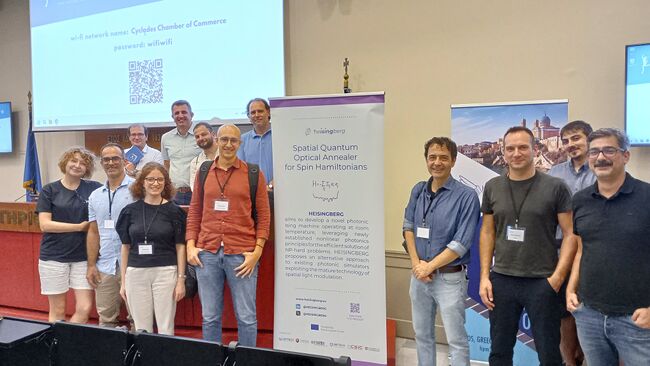 HEISINGBERG
HEISINGBERG

HEISINGBERG is a EU scientific project from the EIC Pathfinder Challenges 2022 call on the HORIZON-EIC-2022-PATHFINDERCHALLENGES-01-06 topic (project ID 101114978), coordinated by Ubitech in Cyprus and with partners: Sapienza (Italy), Forth (Greece), QUBITECH (Greece), Cambridge (UK) and Madrid (Spain), running for 48 months from 1 November (2023) until 31 October (2027).
Its full title is:
Spatial Quantum Optical Annealer for Spin Hamiltonians
Its main objective is to implement the next generation of optical machines simulating complex algorithmic problems after the scheme already demonstrated by Claudio Conti et al.[1] (who are part of the Consortium), including to bring them into the quantum realm.
This page is focused on the participation from the Madrid group, which is to provide the theoretical framework investigating the quantum advantage of the optical XY machine by using quantum light to illuminate the SLM and upgrade measurements to quantum observables, such as photon correlations and quantum tomography.
Abstract
Optical simulators rank among the most promising candidates to power future technological breakthroughs in terms of speed, scalability, power-consumption and quantum advantage, serving a wide range of useful optimization problems. However, the operation of such simulators remains currently limited by noise, the extent of algorithmic problems they can embed and to the classical regime where they compete with supercomputers. HEISINGBERG aims to bring our state-of-the-art spatial photonic spin simulator (an iterated cycle of all-optical processing through a spatial light modulator that couples 10,000 spins) into the quantum regime by upgrading its coherent drive to squeezed light, making it fully programmable through vector-matrix multiplication schemes, use of holography, ancillary spins & effective magnetic fields, and designing dedicated custom-tailored and purpose-built algorithms. The reduced fluctuations in one quadrature of the fields will allow us to scale up and optimize the performances of the existing machine to bring it beyond the capabilities of both classical supercomputers and competing spin-simulators. HEISINGBERG devices will operate 100,000 spins at room temperature and process new quantum annealing algorithms on an improved XY architecture. Besides, the nonclassical resources of squeezed states when modulated, admixed and phase-controlled through beam splitters, such as entanglement or superpositions of multiphoton states will be prospected to harness a quantum advantage and boost our machine into its quantum simulation regime. This development will stimulate the quantum information processing community by concretely articulating problems of algorithmic complexity and clarify the nature of the quantum advantage available in annealers and simulators. These advances will allow us to demonstrate, on a cloud platform, annealing and adiabatic algorithms that can efficiently solve NP-hard problems.
Meetings
Online meetings
- 10 November (2023) Kick-off Meeting, in Athens (I online from Wolverhampton).
- 11 January (2024) Monthly GA meetings.
- 8 February (2024) Monthly GA meetings.
- 23 September (2025) Plenary Meeting.
WP4 meetings
Onsite meetings
- 28–30 April (2024) — Roma general meeting.
- 30 September–5 October (2024) — Syros meeting (HPM 2024) [1][2].
- 7 November (2024) — Visit of Prof. Natalia Berloff [3].
Media Outreach
- The Phase as a Key to Unlock Quantum Correlations (on the
 blog).
blog). - The Ising machine that thinks with N. Berloff (on the
 blog).
blog).
Acknowledgments
This web page is supported by the HEISINGBERG “Spatial Quantum Optical Annealer for Spin Hamiltonians” EU Research and Innovation Project under Grant Agreement No. 101114978.
Links
- https://twitter.com/_HEISINGBERG_
- https://twitter.com/Q_Ubit_Tech
- successful projects for this call.